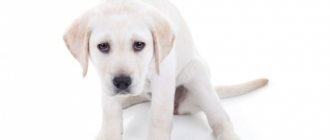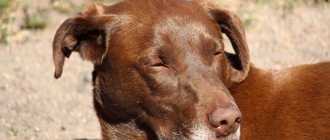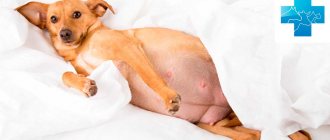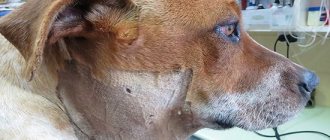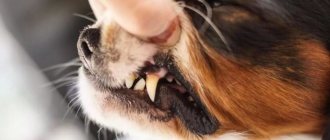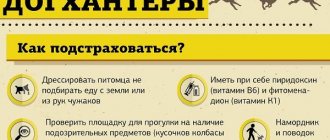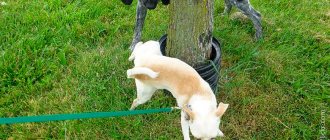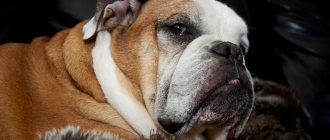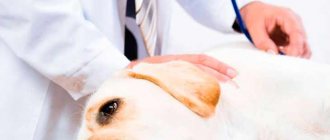Feces are one of the most important indicators of the health of our pets. It is its sudden changes that can become the first alarming signal that prompts the owner to show his pet to a veterinarian before a serious deterioration in the animal’s well-being. Normally, a dog's bowel movements should be brown in color and have a hard consistency. Any deviations from this “standard” indicate an imbalance in the pet’s body - temporary or chronic. Green feces in a dog is one of the variants of a deviation that can put the owner into a stupor. We will talk about the causes of green bowel movements below.
Green feces in a dog
Clinical picture
Green stool is rarely an “isolated” symptom; in most cases it is accompanied by other painful manifestations, allowing the veterinarian to make a more accurate diagnosis.
You can tell if your pet needs veterinary help immediately by the following symptoms:
- increase or decrease in body temperature;
- general depressed state, lack of need for physical activity;
- unjustified weight loss;
- frequent bouts of vomiting (may remain ineffective);
- lack of interest in food, combined with constant thirst;
- frequent urination;
- blanching or yellowing of the mucous membranes.
Infectious diseases are very difficult for dogs
The conditions listed above, as a rule, indicate the occurrence of an inflammatory process in one of the pet’s organs. Only a veterinarian can more accurately determine the affected organ and prescribe adequate treatment.
Symptoms can develop either very gradually or abruptly if we are talking about poisoning with poisons. Unfortunately, with this type of intoxication, the owners sometimes do not have time to run to the doctor before the dog dies.
If there are errors in diet planning, green stools are not accompanied by other painful manifestations
In case of allergies, dysbacteriosis resulting from long-term treatment with antibiotics and the selection of the wrong food, green stool can act as a single symptom, without causing any particular concern in the dog owner (as well as in the dog itself). However, it is important to understand that a change in the shade of bowel movements indicates malfunctions in the body, which sooner or later will lead to more significant deterioration that can no longer be ignored.
What symptoms should you be wary of?
When you need to sound the alarm, seek the help of a specialist:
Reluctance to play, lethargy, weakness.- Sudden weight loss.
- Yellowing or blanching of mucous membranes.
- Regular urge to vomit (sometimes the animal vomits only drool).
- Changes in body temperature (increase, decrease).
- Poor appetite.
- Intense thirst.
- Black-green feces.
Having noticed something wrong, you don’t need to wait for the problem to go away on its own. Severe poisoning is dangerous in itself, and delaying it will only worsen the situation.
Treatment
The treatment regimen is selected after diagnosis, since treating a single symptom without taking into account the overall picture is in most cases pointless. It is important to influence the cause, and not fight the consequences. Of the common medications that are prescribed to animals to eliminate the symptoms of diarrhea, we highlight the main ones:
- antidiarrheal medications such as Phthalazole or Loperamide;
- probiotics (if opportunistic microflora is detected in the intestines);
- enzyme preparations that help normalize the gastrointestinal tract.
Phthalazol for dogs
If green stool appears due to food poisoning, and the examination did not reveal any pathologies, the dog is prescribed enterosorbents, such as activated carbon or Polypefan. Also, dogs that have been poisoned drink Enterosgel, which envelops the walls of the stomach and promotes the rapid removal of toxins from the pet’s body.
Diet
In case of acute and debilitating attacks of diarrhea, dogs are required to be put on a starvation diet, regardless of whether the disease affects a puppy or an adult. The only difference is the time of abstinence from food - puppies are not given food for 12 hours, and adult dogs for the whole day. This condition allows you to cleanse the animal’s digestive tract more effectively, without loading it with new contents.
To completely cleanse the body after intoxication, the dog must follow a starvation diet.
Important! A fasting diet involves active fluid intake, especially with diarrhea. With loose stools, dogs lose a lot of water, which must be replenished to avoid dehydration.
Diet for putrefactive microflora
Putrefactive processes in the intestines will include longer adherence to a diet that involves excluding protein foods from the dog’s diet during recovery. Foods that are high in protein include:
- meat and fish food;
- eggs;
- offal.
Despite the benefits of meat for a dog, the pet should refuse it while the intestines are recovering.
Infectious diseases
If an animal has green stool due to infection, then its treatment involves the use of several types of medications:
- broad-spectrum antibiotics (specific drugs are prescribed by a doctor, who also gives information about the required dosage and duration of treatment;
- anti-inflammatory drugs;
- antipyretic medications.
Treatment errors
The most important mistake a dog owner can make is trying to self-medicate a sick animal. Many inexperienced owners do not consider diarrhea to be one of the symptoms of a serious illness and try to give the animal activated charcoal and other well-known remedies for poisoning.
Under no circumstances should activated charcoal be administered to a dog before consulting a veterinarian.
However, it often happens that green stool has nothing to do with poisoning, and cleansing the body with enterosorbent does not lead to improvement, but on the contrary, aggravates the painful manifestations in the dog. Therefore, any suspicious symptom, no matter how insignificant it may seem, needs diagnosis by a specialist.
You can give your dog strong tea and herbal decoctions only after these measures have been approved by your doctor. Often, pets who have survived poisoning are recommended to drink rice water, which helps restore digestion. This decoction is given four times a day.
Strong tea sometimes allows dogs to recover faster from poisoning
How to treat an animal
Having made a diagnosis, the doctor prescribes a number of medications and explains how to use them..
Groups of medications:
- antidiarrheals;
- preparations with enzymes;
- probiotics.
Antidiarrheal drugs
The main task of medications is to stop incessant diarrhea, which removes fluid from the body.
Atoxil, activated carbon, and Regidron are usually prescribed.
Probiotics
Beneficial bacteria normalize microflora, restoring intestinal balance. Today, pharmacies offer a large number of probiotics that help bring peristalsis back to normal in a short time.
Enzyme products
Enzymes are involved in the digestion process.
Their lack leads to problems associated with the gastrointestinal tract. Special medications help the body break down food. Popular:
- Pancreatin.
- Festal.
- Oraza.
Only a specialist should prescribe medications.
Other stool colors
In addition to green, there are two more colors of feces, which are a sign of deterioration in the pet’s well-being and malfunctions of internal organs:
- white;
- yellow.
White feces
White stool is considered a bad symptom, since it indicates not only the presence of an imbalance in the animal’s body, but also its advanced stage. Normally, healthy dogs do not have white stools, so if you notice whitish bowel movements in your pet, you need to show him to a specialist as soon as possible and undergo examination.
White feces in dogs are usually observed in solid form.
Causes of white stool
Most diagnoses, the presence of which is indicated by the white color of bowel movements, are not reassuring. Among such pathologies are:
- oncology. Whitish stool is one of the main symptoms of a malignant tumor, which in such cases is located either in the digestive organs, or in the liver or gall bladder, preventing the outflow of bile. Unfortunately, it is extremely difficult to detect cancer in the early stages, which is why veterinarians often make mistakes in diagnosis;
- cholelithiasis, as a result of which bile is not able to enter the intestines to participate in food processing. In advanced stages of cholelithiasis, the bile ducts become “clogged” with sand, which forms stones;
Stones formed in the bile ducts of dogs can vary greatly in size.
- hepatitis, which can be both viral and non-viral in nature;
- cholangitis, which is inflammation of the gallbladder;
- cirrhosis or fibrosis of the liver;
- benign tumors (cysts) in the pet’s liver or gall bladder.
Treatment
Treatment of the animal directly depends on the diagnosis. The least favorable prognosis is observed for cancer, since sometimes even surgery is not able to prevent further growth of cancer cells. In turn, not every owner can afford a comprehensive examination of a dog to determine the presence of a tumor due to its impressive cost.
Despite the fact that in the early stages the symptoms of cancer are completely non-specific and can be missed by the owner, every dog owner needs to know about the initial manifestations of this disease.
The first symptoms of cancer in dogs
Liver diseases
For liver problems, dogs are prescribed antibacterial agents, such as:
- Tsiprovet;
- Clavil;
- Biovitin;
- Sinulox.
Sinulox is available in the form of tablets and suspensions
These drugs are effective in combating renal failure and infectious forms of hepatitis. Pets are also often prescribed salt and nutrient solutions that help eliminate intoxication and restore water-salt balance.
For cirrhosis, the following types of medications are prescribed to your dog:
- antispasmodics to relieve pain;
- hepatoprotectors that promote the restoration of liver cells;
- enterosorbents that cleanse the body.
Cholelithiasis
Treatment of gallstone disease involves several options:
- the use of ultrasound – for mild leakage and small stone sizes;
- removal of stones through surgery;
- removal of the bladder – in case of an advanced form of leakage, involving the formation of pointed stones that can cause severe internal injuries to the pet.
The presence of large stones requires surgery
Yellow feces
Yellow feces can appear in dogs in either solid or liquid form. The consistency of stool is certainly taken into account during diagnosis, since different types of pathologies require a certain type of bowel movement.
Yellow feces can be a consequence of both a number of diseases and the consumption of foods with carotene
Causes of yellow stool
The formed type of bowel movements of a yellow hue is characteristic of the following diseases:
- liver related diseases. These include cirrhosis, hepatitis, and liver neoplasia. As a rule, liver dysfunction leads to gradual lightening of stool, and yellowness is just a transitional stage. As already mentioned, a violation of the outflow of bile leads to “whitening” of bowel movements;
- helminthic infestations. As a rule, when infected with protozoa, the animal’s stool remains formed, and diarrhea is observed less frequently. The feces themselves are heterogeneous, since they include the worms themselves and their larvae;
- disturbances in the functioning of the pancreas. When hormones are not produced correctly, the stool becomes characteristically oily, resulting from the body’s inability to cope with fats.
One of the causes of yellow stool is pancreatitis.
By the way! Sometimes the reason for the yellowness of bowel movements lies in a banal unbalanced diet.
The liquid consistency of yellow stool suggests the following diseases:
- viral infections such as salmonellosis or parvovirus. The latter is characterized by the presence of mucus and blood in the stool. Salmonellosis involves the presence of green specks in the stool;
- intestinal infections;
- pancreatic dysfunction.
As in the case of hard yellow stools, its liquid variation can also be associated with an unhealthy diet, which includes excess amounts of fats found in butter and high-calorie offal.
It is undesirable for dogs to consume carrots and other foods high in carotene due to their inability to absorb it.
Among other things, the stool may turn yellow due to staining that occurs as a result of the digestion of foods such as:
- carrot
- vegetables and cereals enriched with carotene.
The reason for this coloring is that the dog’s body is unable to digest carotene, and therefore removes it from the body intact, causing concern to the owners.
Mistakes that can lead to poor health
The Internet has led to the fact that most people treat themselves and treat their pets. An incorrect diagnosis leads to a deterioration in the animal's well-being .
Always dangerous:
- self-medication;
- thoughtless use of traditional medicine.
Self-medication
Independent choice of treatment leads to a blurred picture of the animal’s condition and complications when making a diagnosis. This can lead to the death of the pet.
It is better to do nothing than to give the dog the pills that came to hand first.
Unjustified use of folk remedies
What helps people is sometimes harmful to animals. Many plants are contraindicated for four-legged people. For smaller friends they are toxic and cause severe poisoning.
What you need to know about dog poop
Many dog breeders do not have a sufficient level of knowledge regarding the norms and pathologies of canine bowel movements. Meanwhile, monitoring the condition of a dog's feces is one of the ways to obtain valuable information about the health and well-being of the pet.
Types of feces in dogs
In the table below we have collected the main characteristics of dog feces, affecting both pathological and healthy areas of physiology.
Table 1. Types of feces in dogs
| Type | Causes |
| Liquid feces | 1. Bacterial or viral infections; 2. Dysbacteriosis; 3. Helminthiasis; 4. Giardiasis; 5. Intestinal inflammation; 6. Pancreatitis (inflammation of the pancreas); 7. Consequences of intoxication of the body |
| Dry stool for constipation | 1. Intestinal obstruction/obstruction; 2. Gastrointestinal obstruction due to tumors, polyps or abscesses; 3. Disturbances in the production of hormones (hypothyroidism); 4. Parasitic infestation; 5. Consequences of taking certain diuretics or antihistamines; 6. Poor nutrition, too much dry food and not enough water |
| Bloody feces | Inflammatory processes in the large intestine (colitis), resulting from various reasons - from the consumption of low-quality feed to infection |
| Black stool with dark blood | Bleeding in some parts of the gastrointestinal tract |
| Yellow feces | 1. Pancreatic dysfunction; 2. Intestinal infections; 3. Viral infections; 4. Liver dysfunction; 5. Giardiasis |
| White feces | 1. Malignant or benign tumors; 2. Gallstone disease; 3. Inflammation of the liver or gall bladder; 4. Cirrhosis or fibrosis of the liver |
| Green feces | 1. Malfunctions of the liver; 2. Inflammation of the gastrointestinal tract; 3. Parasitic infestations; 4. Gallstone disease; 5. Allergy; 6. Poisoning by chemicals or poison |
| Stool with mucus | 1. In small quantities this is normal; 2. In other cases, inclusions of mucus may indicate dysbacteriosis, colitis, gastroenteritis or helminthiasis |
Prevention measures
In order for the color of the dog’s stool to be normal, and for the animal itself to live a full life and behave playfully, it is necessary:
- Monitor your pet's diet.
- Adhere to hygiene measures (bathing and cleaning the fur from various parasites).
- Carry out examinations and vaccinations.
- Do not change living conditions without serious reasons.
The first thing you should do when changing your stool is to contact your veterinarian.
If your dog starts pooping loosely or the color of its feces has changed, then you should take immediate action. If this symptom is correlated with apathy or loss of appetite, consult a doctor as soon as possible for advice and help. This applies to all breeds: shepherds, Dobermans, pugs, Yorkies and so on.
Gray diarrhea in a dog. Rostov-on-Don, choice of clinic.
- Veterinary clinic Zoodrug . Khalturinsky Lane, 156. An initial appointment with a therapist costs 300 rubles, and a gastroenterologist 500 rubles.
- Center for Veterinary Medicine . St. Belorusskaya, 203a. Around the clock. Initial appointment 260 rubles. There is a doctor call service.
- Veterinary clinic Amigo . St. Metallurgicheskaya, 36/19, floor 1. Around the clock. Initial appointment 350 rubles.
- Vet service . St. 18 line, 76. Examination by a therapist 350 rubles.
- Clinic of veterinary care of Dr. Zubkov . St. Profsoyuznaya 47. The clinic has a hospital service.
- Doctor Cat . St. Lermontovskaya 161. Call service, a call costs 500 rubles.
- Veterinary complex Umka . St. Lenina, 42. Calling a doctor to your home costs 300 rubles. Examination and consultation - 250 rubles.
Users of the Zoon website note the high professionalism of the Zoodrug clinic specialists. The administrators and chief physician of the Doctorkot and Amigo clinics also received positive comments.
Diarrhea and vomiting: possible causes
If your dog has diarrhea and also vomits, especially repeatedly, and has a fever, you should not put off visiting the veterinarian.
Causes of vomiting and diarrhea:
- overeating - one-time or short-term vomiting is observed;
- food poisoning - may vomit several times;
- entry of a foreign body - a characteristic sign is profuse foamy vomiting, sometimes with blood;
- poisoning with chemicals, including inhalation, for example, if something was painted in the apartment or near the enclosure;
- switching to new food;
- helminthiasis - vomits immediately after feeding;
- parvovirus enteritis - the disease is observed mainly in animals aged 2 to 6 months, the puppy vomits and does not eat;
- rotavirus infections, adenovirus - are observed at any age, the mucous membrane of the eyes becomes inflamed, the liver enlarges.
Where to go in St. Petersburg?
- Network of veterinary clinics Kotonai . Per. Alpiysky, 29. Chief physician, gastroenterologist Degtyareva Yu.Yu. Appointment with a therapist is 700 rubles, a specialist is 1200.
- Vega veterinary clinic network . Branch st. Pulkovskaya 11 building 1. The appointment is conducted by gastroenterologist E.A. Gaidarenko. Appointment with a therapist costs 500 rubles.
- Network of veterinary clinics Cityvet . Exists for more than 10 years. More than 1000 positive reviews. There are often promotions and discounts on services. Reception 650 rubles, specialist - 1000 rubles.
- Veterinary Clinic named after. Ivan Fillmore . Etc. Engelsa, 154. Appointment with a therapist: 1,500 rubles. There is a department for working with homeless animals.
- Network of veterinary clinics of Dr. Sotnikov . Over 13 years of work, more than 150,000 happy patients. Initial appointment with a therapist is 1200 rubles.
The reviews noted the convenience of a separate infectious diseases hospital in the clinic named after. Ivan Fillmore and the presence of a CT scan. Dr. Sotnikov’s clinic has its own modern veterinary laboratory “Poisk”, the results are ready quite quickly. In the Vega and Kotonai clinics there is a gastroenterologist who can perform an ultrasound immediately at the appointment.
Quantity
Uncomplicated diarrhea
The first thing you need to do when you discover that your pet has diarrhea is to make sure that it is uncomplicated and can be treated at home. The following symptoms are typical for uncomplicated diarrhea:
- stool more than 4-5 times a day;
- thin or watery stool consistency;
- gurgling in the stomach;
- the dog whines when he defecates;
- apathetic or agitated behavior;
- refusal of food;
- thirst.
In this case, the dog’s diet is adjusted, tablets for diarrhea are given and the opportunity to drink clean water without restrictions. A diet for indigestion is necessary for 3-4 days after the diarrhea has stopped.
To normalize digestion, dogs are prescribed homeopathic medicines, which are presented in our online store:
note
Quick view
LIARSIN homeopathic medicine for the correction of metabolic processes, prevention and treatment of diseases of the gastrointestinal tract, solution for injection (10 ml)
10 ml
328 ₽
Show all offers
Quick view
PANCREALEX homeopathic medicine for the treatment of diseases of the gastrointestinal tract, solution for injection (10 ml)
10 ml
337 ₽
Show all offers
If after 3 days the stool has not returned to normal, or the pet continues to diarrhea, a veterinarian’s consultation is necessary. Treatment with strong antibiotics can only be prescribed by a doctor.
